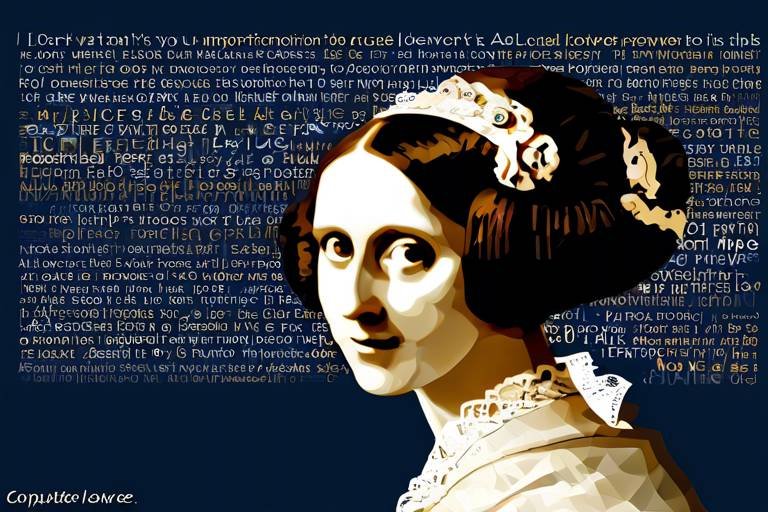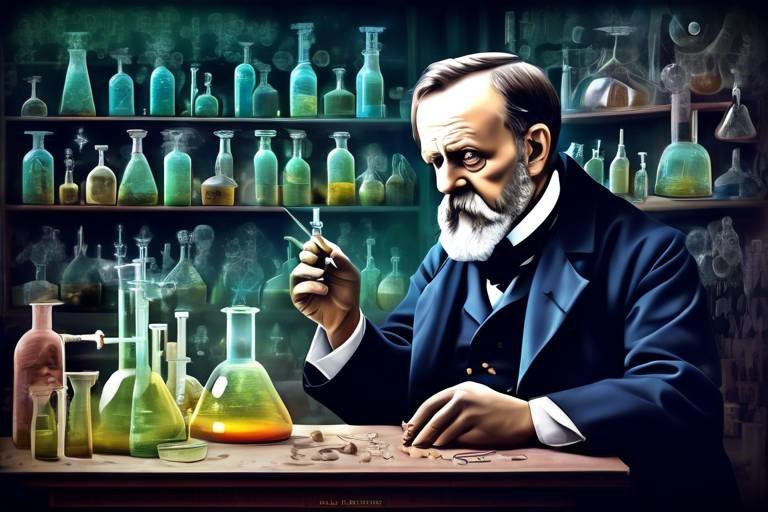The Contributions of Ada Lovelace to Computer Science
Ada Lovelace, often hailed as the **first computer programmer**, made groundbreaking contributions to the field of computer science in the 19th century. Her insights and visionary thinking laid the foundation for what we now consider modern computing. But who was Ada Lovelace, and why is she so significant in the realm of technology? To truly appreciate her contributions, we must delve into her early life, her collaboration with Charles Babbage, and the legacy she left behind.
Born in 1815, Ada was the daughter of the famous poet Lord Byron and his wife, Annabella Milbanke. Her mother, a mathematician herself, ensured that Ada received a rigorous education in mathematics and science, which was quite unusual for women of her time. This early exposure to mathematical concepts and logical reasoning would ultimately shape her future endeavors. Lovelace's education was not just about numbers; it was a blend of art and science, a theme that would resonate throughout her work.
Her collaboration with Charles Babbage, known as the "father of the computer," marked a pivotal moment in her life. Babbage was working on his revolutionary machine, the Analytical Engine, and Lovelace quickly became fascinated by its potential. She recognized that this machine could do far more than just perform calculations; it could manipulate symbols and create complex outputs based on the input it received. This realization was nothing short of revolutionary and showcased her ability to think beyond the conventional boundaries of her time.
One of her most significant contributions was the creation of what is often regarded as the **first algorithm** intended for implementation on a machine. This algorithm was designed to calculate Bernoulli numbers, and it was a testament to her deep understanding of the Analytical Engine's capabilities. It is fascinating to think that this early program laid the groundwork for the programming languages we use today. Lovelace's work not only established her as a foundational figure in programming history but also demonstrated her visionary insights into the future of computing.
Moreover, Lovelace's foresight about the potential of computers went beyond mere calculations. She envisioned a time when machines could be used for artistic expression, suggesting that computers could manipulate not just numbers but also music and graphics. This idea was revolutionary, as it anticipated the multifaceted applications of computing that we see in our modern world. Lovelace's thoughts on the **intersection of technology and creativity** continue to inspire countless innovators today.
In addition to her groundbreaking work, Ada Lovelace's legacy has become a beacon of inspiration for women in technology. For many years, her contributions were overshadowed by her male counterparts, but recent efforts have brought her story to the forefront. Celebrations such as **Ada Lovelace Day** honor her achievements and encourage future generations of women to pursue careers in science, technology, engineering, and mathematics (STEM). This annual event serves as a reminder of the importance of diversity in tech and the need to recognize the contributions of women throughout history.
Today, Lovelace's influence can be seen in various aspects of modern computing. Her insights have shaped programming languages and the way we conceptualize algorithms and data processing. The principles she laid out in her notes on the Analytical Engine resonate with the way we approach problem-solving in computer science today. Lovelace's work is a testament to the idea that innovation knows no gender and that the seeds of today’s technology were planted long ago by visionary thinkers like her.
- What is Ada Lovelace best known for?
Ada Lovelace is best known for her work on the Analytical Engine and is often credited as the first computer programmer for creating the first algorithm intended for implementation on a machine. - How did Ada Lovelace influence modern computing?
Her insights into the potential of computers to perform tasks beyond simple calculations laid the groundwork for future developments in programming and artificial intelligence. - Why is Ada Lovelace celebrated today?
Ada Lovelace is celebrated for her pioneering contributions to computer science and as a symbol of women's achievements in technology through events like Ada Lovelace Day.

Early Life and Education
Ada Lovelace was born on December 10, 1815, in London, England, to the renowned poet Lord Byron and his wife, Annabella Milbanke. Her parents' tumultuous relationship ended when Ada was just a month old, leading her mother to raise her in a strict and intellectually stimulating environment. Annabella, a mathematician herself, was determined that her daughter would not follow in her father’s poetic footsteps, but instead cultivate a strong foundation in mathematics and science. This early influence was crucial, as it nurtured Ada's natural curiosity and intellect, setting the stage for her groundbreaking contributions to computer science.
From a young age, Ada displayed a remarkable aptitude for mathematics and an insatiable thirst for knowledge. Her mother ensured that she received a comprehensive education, employing private tutors to teach her subjects like mathematics, science, and even music. One of her most significant mentors was the mathematician Augustus De Morgan, who recognized her talent and encouraged her to pursue her interests in a field dominated by men. Ada's education was not just about rote learning; it was a blend of rigorous academic training and creative thinking, which would later play a vital role in her innovative work.
As a child, Lovelace was fascinated by machines and how they worked. She often engaged in imaginative play, creating complex designs and models. One of her most famous childhood projects was a flying machine, which she meticulously designed based on the principles of physics she learned from her tutors. This early fascination with mechanics and engineering laid the groundwork for her future collaboration with Charles Babbage.
In 1833, Ada met Babbage at a dinner party, a meeting that would change the course of her life. Babbage was already working on his revolutionary Analytical Engine, a concept that would eventually lead to the development of modern computers. Lovelace was captivated by the machine and its potential, and soon after, she began working closely with Babbage, applying her mathematical skills to help refine his designs. This collaboration was not just a professional relationship; it was a partnership that would see Ada become the first person to recognize the immense possibilities of computing.
Throughout her life, Lovelace remained committed to her education and intellectual pursuits. She corresponded with some of the leading scientists of her time, including Michael Faraday and Charles Wheatstone, further expanding her knowledge and network. Despite the societal constraints placed on women in the 19th century, Ada Lovelace's upbringing and education were instrumental in shaping her into one of the most influential figures in the history of computing.

Collaboration with Charles Babbage
When we think about the dawn of computing, one name inevitably pops up: Charles Babbage. But guess what? He wasn't working alone. Enter Ada Lovelace, a brilliant mind whose partnership with Babbage would change the course of technology forever. Their collaboration was not just a meeting of two intellectuals; it was a fusion of ideas that sparked the imagination and laid the groundwork for modern computing. Lovelace and Babbage's relationship was akin to that of a painter and their muse, where each inspired the other to reach new heights of creativity and innovation.
In the early 19th century, Babbage was conceptualizing the Analytical Engine, an ambitious project that aimed to be the first mechanical computer. Lovelace, who had already shown an aptitude for mathematics and a deep curiosity about the workings of machines, became fascinated by Babbage's ideas. Their collaboration was more than just a professional relationship; it was a partnership that bridged the gap between mathematics and machine programming. Lovelace's unique perspective allowed her to see the potential of Babbage's machine beyond simple calculations. She envisioned a future where machines could perform complex tasks, manipulate symbols, and even create art.
What set Lovelace apart was her ability to grasp the underlying principles of Babbage's designs. She didn’t just understand the mechanics; she saw the bigger picture. For instance, Lovelace wrote extensive notes on the Analytical Engine, which included what is now recognized as the first algorithm intended for implementation on a machine. This algorithm was not merely a set of instructions; it was a blueprint for future programming languages. In her notes, she articulated concepts that would take over a century to fully materialize, such as the idea that machines could go beyond mere calculations and be used for more creative purposes. It’s almost poetic when you think about it—Lovelace was not just coding; she was composing a symphony of logic and creativity.
To illustrate their collaboration, consider the following table that highlights key aspects of their partnership:
| Aspect | Ada Lovelace | Charles Babbage |
|---|---|---|
| Role | Mathematician and Programmer | Inventor and Theorist |
| Key Contribution | First algorithm for a machine | Design of the Analytical Engine |
| Vision | Envisioned machines as tools for creativity | Focused on mathematical calculations |
| Legacy | First computer programmer | Father of the computer |
Through their collaboration, Lovelace not only contributed to the development of the Analytical Engine but also established herself as a visionary who understood the implications of computing long before it became a reality. It’s easy to overlook her contributions when discussing the history of computing, but her insights were revolutionary. Lovelace's ability to see beyond the immediate functionality of Babbage's invention allowed her to dream of a world where computers could do much more than crunch numbers. This foresight is what makes her partnership with Babbage so significant, as it transformed a mechanical contraption into a precursor of modern computers.

Understanding the Analytical Engine
The Analytical Engine, designed by the brilliant inventor Charles Babbage, was nothing short of revolutionary. Imagine a machine that could not only perform calculations but could also follow a set of instructions to solve complex problems. This was the vision that Babbage had, and Ada Lovelace was the one who truly understood its profound implications. She saw beyond the numbers and equations; she envisioned a world where machines could manipulate symbols and create something entirely new. It was like seeing a painting before the canvas was even touched by a brush.
Lovelace's grasp of the Analytical Engine was remarkable. She recognized that this machine was not merely a calculator; it was a universal machine capable of performing any mathematical operation given the right instructions. In her notes, she articulated the concept of an algorithm, which is essentially a step-by-step procedure for calculations. This was groundbreaking because it laid the foundation for what we now understand as programming. To put it simply, Lovelace was writing the first computer program, and in doing so, she was opening the door to a future filled with possibilities.
One of the most fascinating aspects of the Analytical Engine is its ability to handle not just numbers but also symbols, which meant it could potentially create music, art, and even poetry. Lovelace imagined a future where machines could create in ways that were previously thought to be exclusive to humans. This visionary insight is what sets her apart from her contemporaries. She was not just a mathematician; she was a thinker, a dreamer, and a pioneer. Her understanding of the machine's capabilities was akin to realizing that the invention of the wheel could lead to the creation of cars, planes, and beyond.
To clarify the key features of the Analytical Engine that Lovelace understood, consider the following table:
| Feature | Description |
|---|---|
| Input | The machine could take input in the form of punched cards, similar to those used in Jacquard looms. |
| Storage | It had a memory unit, referred to as the 'store,' which could hold numbers and intermediate results. |
| Processing | The 'mill' was the processing unit, where calculations and operations were performed. |
| Output | Results could be printed or visualized in various forms, including graphs and charts. |
In essence, Lovelace's understanding of the Analytical Engine was not just about its mechanical components; it was about its potential to transform society. She foresaw a time when machines would not only assist in calculations but would also enhance human creativity and intellect. This was a radical thought during her era, and it is a testament to her forward-thinking nature. Ada Lovelace was not merely a participant in the early days of computing; she was a visionary who laid the groundwork for future generations of computer scientists and programmers.

First Algorithm
Ada Lovelace's groundbreaking work on the first algorithm for the Analytical Engine is a monumental achievement in the history of computing. This algorithm is often heralded as the first computer program, marking a pivotal moment in the evolution of technology. Imagine a world where the mere concept of a "program" didn't exist—this was the reality before Lovelace stepped onto the scene. She took the theoretical framework laid out by Charles Babbage and transformed it into something tangible and executable. Her algorithm was designed to calculate Bernoulli numbers, a complex mathematical sequence, and it required a level of foresight and understanding that was unprecedented for her time.
To comprehend the significance of her contribution, it's essential to recognize that Lovelace wasn't just transcribing Babbage's ideas; she was actively engaging with them, envisioning how they could be applied in ways that went far beyond simple calculations. In her notes, she elaborated on how the Analytical Engine could be programmed to perform various tasks, manipulating symbols and numbers in a way that could even create art. This was revolutionary! It was as if she were peering into a crystal ball, predicting a future where machines could not only compute but also think and create.
In her notes, Lovelace famously stated, “The Analytical Engine does not occupy common ground with mere calculating machines.” This statement encapsulates her visionary insights, highlighting her belief that computers could transcend their initial purpose and evolve into tools for creativity and expression. Her algorithm was not just a series of instructions; it was a blueprint for the future of programming, laying the groundwork for the intricate software development we see today.
To further illustrate the impact of her first algorithm, consider the following table that outlines the key elements of her work:
| Element | Description |
|---|---|
| Algorithm Purpose | To calculate Bernoulli numbers using the Analytical Engine. |
| Innovative Aspects | First instance of a machine being programmed to perform a complex mathematical operation. |
| Visionary Insights | Envisioned computers as tools for creativity, not just calculation. |
| Legacy | Established a foundation for modern programming languages and software development. |
In summary, Ada Lovelace's first algorithm was not only a technical achievement but also a profound statement about the potential of computing. It was a glimpse into a world where machines could be more than mere calculators—they could be instruments of innovation and creativity. Lovelace's work continues to inspire and influence the field of computer science, reminding us that the roots of programming lie in her visionary ideas and groundbreaking contributions.
- What did Ada Lovelace contribute to computer science?
Ada Lovelace is credited with creating the first algorithm intended for implementation on a machine, making her the first computer programmer. - Why is Ada Lovelace considered a pioneer?
She not only developed the first algorithm but also envisioned the potential of computers to go beyond calculations, including artistic creation. - What is the significance of her algorithm?
Her algorithm laid the foundation for modern programming and demonstrated the capabilities of machines to perform complex tasks.

Visionary Insights
Ada Lovelace wasn't just a mathematician; she was a true visionary, someone who saw beyond the mechanical gears and cogs of her time. Imagine standing on the edge of a vast ocean, knowing that beneath the surface lies an entire world waiting to be discovered. That's precisely how Lovelace approached the concept of computing. She understood that the Analytical Engine, designed by Charles Babbage, was not merely a calculator but a gateway to a future brimming with possibilities. While others saw it as a tool for performing arithmetic, Lovelace envisioned a machine capable of manipulating symbols and creating art, music, and complex computations.
Her insights were revolutionary. Lovelace recognized that the Analytical Engine could operate on any data, not just numbers. This was akin to realizing that a canvas could hold more than just paint; it could tell stories, evoke emotions, and inspire change. She famously stated, “The Analytical Engine does not occupy common ground with mere calculating machines.” This statement captures her belief that machines could transcend their original purpose, paving the way for the multifaceted roles technology plays today.
Moreover, Lovelace's understanding of the interplay between mathematics and creativity was profound. She foresaw that computers could be programmed to perform tasks that were not just logical but also artistic. This insight laid the groundwork for what we now refer to as algorithmic art and computer-generated music. Her ability to think outside the box was not just a reflection of her intelligence; it was a glimpse into the future of technology and its integration into various aspects of human life.
To further illustrate her visionary insights, consider the following points:
- Symbol Manipulation: Lovelace understood that computers could manipulate symbols, not just numbers, allowing for complex problem-solving beyond arithmetic.
- Algorithmic Thinking: She laid the foundation for programming by creating the first algorithm, demonstrating that machines could follow a sequence of instructions to achieve a goal.
- Interdisciplinary Impact: Lovelace’s vision of computing transcended mathematics, influencing fields such as art, music, and science.
In essence, Ada Lovelace's visionary insights were not limited to the technology of her time. They resonate deeply with the advancements we see today in artificial intelligence and data processing. Her ability to foresee a world where machines could augment human creativity and intelligence continues to inspire innovators and thinkers. Lovelace's legacy is a reminder that the most profound ideas often come from those who dare to dream beyond the confines of their reality.
Q: What was Ada Lovelace's most significant contribution to computer science?
A: Ada Lovelace is credited with creating the first algorithm intended for implementation on a machine, which is considered the first computer program.
Q: How did Ada Lovelace's insights influence modern computing?
A: Her visionary ideas about the potential of computers to manipulate symbols and perform creative tasks laid the groundwork for developments in programming, artificial intelligence, and algorithmic art.
Q: Why is Ada Lovelace celebrated today?
A: Ada Lovelace is celebrated for her pioneering work in computer science and her role as a symbol of women's contributions to technology and innovation.

Legacy in Computer Science
Ada Lovelace's contributions to computer science are nothing short of revolutionary. Her pioneering work has not only established her as a foundational figure in programming history but has also inspired countless individuals in the field of technology. Imagine a world where the very concept of programming didn't exist; Lovelace was one of the first to envision a future where machines could perform complex tasks beyond simple calculations. This vision set the stage for what we now recognize as the modern computing landscape.
One of the most remarkable aspects of Lovelace's legacy is her role in advocating for the potential of computers to transcend mere arithmetic. She famously stated, "The Analytical Engine does not occupy common ground with mere calculating machines." This insight foreshadowed the multifaceted capabilities of computers, which we now utilize for everything from art creation to scientific modeling. Lovelace's understanding that machines could manipulate symbols and perform tasks akin to human creativity was groundbreaking.
Moreover, Lovelace's foresight regarding the future of computing has influenced various domains, including artificial intelligence and computational theory. Her belief that machines could be programmed to perform tasks requiring intelligence laid the groundwork for innovations we see today. For instance, the algorithms that power modern AI systems can trace their conceptual roots back to Lovelace's pioneering work on the Analytical Engine. This connection illustrates how her ideas have permeated through time, influencing not just programming languages but also the way we think about data processing and algorithm design.
As we reflect on Lovelace's legacy, it’s essential to recognize her as a symbol of women in technology. In an era when women were often relegated to the background, Lovelace emerged as a beacon of possibility. Her story serves as an inspiration for young women pursuing careers in STEM fields, reminding them that they too can leave a lasting impact on the world. The celebration of her contributions has led to events like Ada Lovelace Day, which honors women’s achievements in science, technology, engineering, and mathematics, fostering a community that encourages future generations to dream big.
In summary, Ada Lovelace's legacy in computer science is characterized by her visionary insights and groundbreaking contributions. She not only laid the foundations for programming but also opened the door for future advancements in technology. Her story is a powerful reminder of the importance of diversity in innovation and the endless possibilities that arise when we dare to think differently.
- Who was Ada Lovelace? Ada Lovelace was a mathematician and writer, known for her work on Charles Babbage's early mechanical general-purpose computer, the Analytical Engine. She is often credited as the first computer programmer.
- What is Ada Lovelace Day? Ada Lovelace Day is an annual celebration of women’s achievements in science, technology, engineering, and mathematics, held on the second Tuesday of October.
- Why is Ada Lovelace important in computer science? Lovelace is considered a pioneer in the field because she created the first algorithm intended for implementation on a machine, making her one of the first programmers in history.

Recognition and Honors
Ada Lovelace's contributions to the world of computing were not fully appreciated during her lifetime, but as the years have passed, her groundbreaking work has gained the recognition it deserves. In recent decades, there has been a significant resurgence of interest in her contributions, positioning her as a key figure in the narrative of computer science. This transformation in perception highlights how society's understanding of technology and its pioneers has evolved. Today, Lovelace is celebrated not just as a mathematician and writer, but as a visionary who foresaw the potential of computers long before they became a reality.
One of the most notable acknowledgments of her legacy is the establishment of Ada Lovelace Day, which occurs annually on the second Tuesday of October. This special day serves multiple purposes:
- It celebrates the achievements of women in science, technology, engineering, and mathematics (STEM).
- It aims to inspire young girls and women to pursue careers in these fields.
- It raises awareness about the gender gap in STEM careers and the importance of diverse perspectives in technology.
Ada Lovelace Day has become a global phenomenon, with events organized in various countries, featuring talks, workshops, and discussions aimed at promoting the contributions of women in technology. These events not only honor Lovelace's legacy but also encourage dialogue about the future of women in STEM, fostering a community of support and inspiration.
Furthermore, Lovelace's legacy is recognized through various awards and honors named after her. These accolades often highlight the achievements of women in technology and encourage innovation and creativity in computing. For instance, the Ada Lovelace Award is presented to individuals who have made significant contributions to the field of computing, particularly in promoting diversity and inclusion.
In educational institutions, Lovelace's impact is also acknowledged through scholarships and programs aimed at encouraging young women to engage with computer science. Many universities and organizations have created initiatives that not only celebrate her contributions but also actively work to dismantle the barriers that have historically kept women out of tech fields.
In the digital realm, Lovelace’s influence is felt in various ways. Numerous software projects, programming languages, and even tech companies have drawn inspiration from her work. For example, the programming language Augusta, named after her, seeks to embody her spirit of innovation and creativity in computing. This naming serves as a reminder of her pioneering status and the enduring relevance of her ideas in today’s technological landscape.
As we reflect on Ada Lovelace's legacy, it's clear that her contributions have transcended time, inspiring not only those who work in technology but also those who strive for equality and representation in all fields. Her story is a powerful reminder that visionaries can emerge from any background, and that their ideas can shape the future in unimaginable ways.
- What is Ada Lovelace known for?
Ada Lovelace is primarily known for her work on Charles Babbage's Analytical Engine, where she created what is often considered the first computer program. - Why is Ada Lovelace Day important?
Ada Lovelace Day celebrates the achievements of women in STEM fields and aims to inspire future generations to pursue careers in these areas. - How has Ada Lovelace's legacy influenced modern computing?
Her visionary insights into computing and algorithms continue to resonate today, influencing programming languages and the conceptualization of data processing.

Ada Lovelace Day
Ada Lovelace Day is not just a date on the calendar; it’s a powerful reminder of the incredible contributions women have made in the fields of science, technology, engineering, and mathematics (STEM). Celebrated annually on the second Tuesday of October, this day serves as a tribute to Ada Lovelace herself, who is often regarded as the world's first computer programmer. The day encourages people to recognize and honor the achievements of women in these fields, fostering a sense of community and inspiration.
But what makes Ada Lovelace Day so significant? It’s more than just a celebration; it’s a call to action. The day aims to:
- Raise Awareness: Highlight the achievements of women in STEM, showcasing their contributions and innovations.
- Encourage Participation: Inspire young girls and women to pursue careers in technology and science, breaking down stereotypes and barriers.
- Foster Community: Create networks and support systems for women in STEM, allowing them to share their experiences and learn from one another.
Events are held worldwide, ranging from talks and workshops to social media campaigns, where individuals share stories of inspiring women in technology. Schools and organizations often use this day to educate students about Ada Lovelace’s groundbreaking work and the importance of diversity in STEM fields. By doing so, they not only honor Lovelace's legacy but also pave the way for future generations of female innovators.
In recent years, Ada Lovelace Day has gained traction, with numerous organizations and educational institutions participating in the celebration. It's heartening to see how this day has evolved into a global movement, uniting people to advocate for gender equality in STEM. The impact of Ada Lovelace Day goes beyond just one day of recognition; it plants seeds of change that can grow into a more inclusive future for all.
As we celebrate Ada Lovelace Day, we are reminded of the importance of representation in technology. Lovelace’s legacy is not just about her contributions to early computing but also about the doors she opened for women in a field that has historically been male-dominated. By honoring her memory, we encourage a culture where everyone, regardless of gender, can thrive and contribute to the ever-evolving world of technology.
Q1: What is Ada Lovelace Day?
Ada Lovelace Day is an annual celebration that honors the achievements of women in science, technology, engineering, and mathematics (STEM), commemorating the legacy of Ada Lovelace, the first computer programmer.
Q2: When is Ada Lovelace Day celebrated?
Ada Lovelace Day is celebrated on the second Tuesday of October each year.
Q3: How can I participate in Ada Lovelace Day?
You can participate by attending events, sharing stories of inspiring women in STEM on social media, or organizing activities in your community to raise awareness about women's contributions to these fields.

Influence on Modern Computing
Ada Lovelace's visionary insights have left an indelible mark on the landscape of modern computing. Her understanding of the Analytical Engine was not merely limited to the mechanics of computation; she foresaw a future where machines could do much more than just crunch numbers. Lovelace's belief that machines could manipulate symbols and create art was revolutionary, laying the groundwork for concepts that are integral to today's technology.
In the realm of programming, Lovelace's pioneering work on the first algorithm for the Analytical Engine is often hailed as the inception of computer programming. This early algorithm was not just a set of instructions; it was a profound realization that machines could follow a sequence of operations to achieve complex tasks. This notion has evolved into what we now recognize as programming languages, which are the backbone of software development today.
Moreover, Lovelace's ideas about the potential of computers to go beyond arithmetic calculations have significantly influenced the development of artificial intelligence and machine learning. Her foresight that computers could be used to manipulate not only numbers but also abstract concepts has paved the way for advancements in data processing and algorithmic design. Today, algorithms are not just tools for computation; they are the frameworks through which we understand and interact with the digital world.
To illustrate Lovelace's impact on modern computing, consider the following table that highlights key areas influenced by her work:
| Area of Influence | Description |
|---|---|
| Programming Languages | Her algorithmic approach laid the foundation for the development of high-level programming languages. |
| Artificial Intelligence | Lovelace's ideas about machines creating art and manipulating symbols foreshadowed modern AI applications. |
| Data Processing | The concept of algorithms as a means to process and analyze data has its roots in her work. |
Additionally, Lovelace's legacy serves as a powerful reminder of the importance of diversity in technology. Her story inspires countless women and underrepresented groups in STEM fields to pursue careers in technology and innovation. The impact of her work can be seen in the increasing emphasis on inclusivity and representation in tech, which is essential for fostering creativity and driving progress in the industry.
In conclusion, Ada Lovelace's contributions to modern computing are not only historical milestones but also ongoing influences that continue to shape our understanding of technology. Her visionary ideas remind us that the potential of computing is limitless, and her legacy is a beacon for future generations of innovators.
- What is Ada Lovelace best known for? Ada Lovelace is best known for her work on the Analytical Engine and for writing what is considered the first computer program.
- How did Ada Lovelace influence modern computing? Lovelace's insights into algorithms and the potential of machines to manipulate symbols laid the groundwork for programming languages and artificial intelligence.
- Why is Ada Lovelace celebrated today? She is celebrated for her pioneering contributions to computer science and as a symbol of women's achievements in technology.
Frequently Asked Questions
- Who was Ada Lovelace?
Ada Lovelace was a mathematician and writer, often regarded as the first computer programmer. She is best known for her work on Charles Babbage's Analytical Engine, where she created the first algorithm intended for implementation on a machine.
- What contributions did Ada Lovelace make to computer science?
Ada Lovelace's key contributions include the creation of the first computer program and her visionary insights into the potential of computers beyond mere calculations. She foresaw that computers could be used for more than just arithmetic, predicting their ability to manipulate symbols and create art.
- What is the Analytical Engine?
The Analytical Engine was a proposed mechanical general-purpose computer designed by Charles Babbage. It is considered the first concept of a modern computer, and Lovelace's work on it laid the groundwork for future computing innovations.
- Why is Ada Lovelace considered a pioneer in programming?
Ada Lovelace is considered a pioneer in programming because she wrote the first algorithm intended for a machine, which is recognized as the first computer program. Her foresight about the capabilities of computers established her legacy in the field of computer science.
- What is Ada Lovelace Day?
Ada Lovelace Day is an annual celebration that honors the achievements of women in science, technology, engineering, and mathematics (STEM). It serves to recognize Lovelace’s contributions and inspire future generations of women in these fields.
- How has Ada Lovelace influenced modern computing?
Ada Lovelace's insights continue to resonate in modern computing by influencing programming languages and shaping our understanding of algorithms and data processing. Her visionary ideas have laid a foundation that modern technology builds upon.
- Why was Ada Lovelace's work overlooked for many years?
Despite her groundbreaking contributions, Ada Lovelace's work was often overshadowed by her male contemporaries and not fully recognized until recent decades. Societal norms of her time often relegated women's contributions to the background, but recent recognition has finally brought her achievements to light.



















